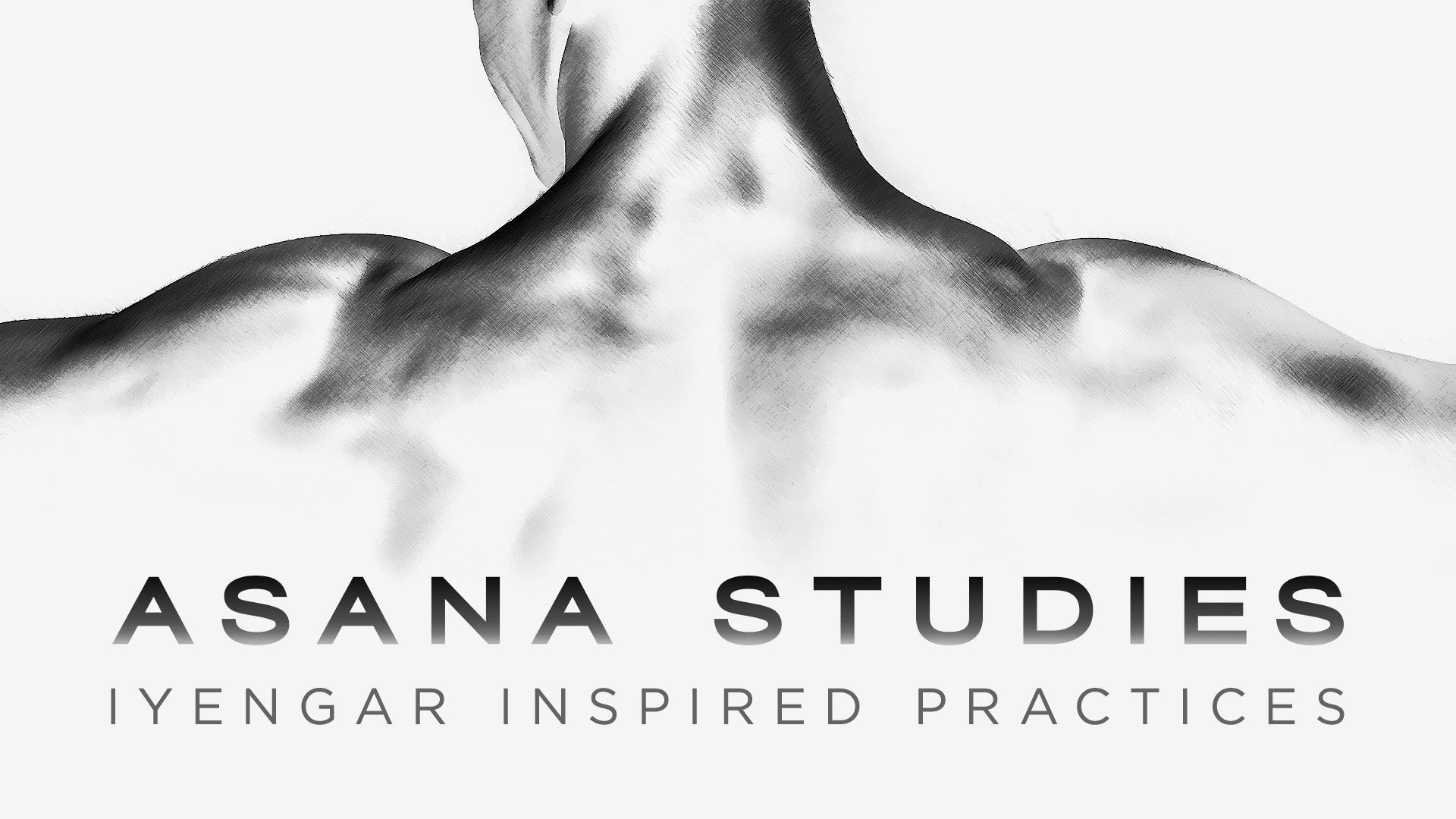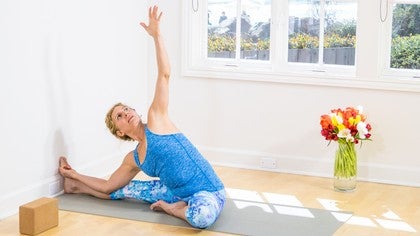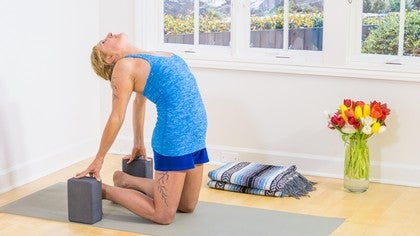Description
About This Video
Transcript
Read Full Transcript
(waves crashing) Hello and welcome. We are going to do a shoulder series focusing on rebalancing how the shoulder girdle rests on the rib cage. The first thing that we're gonna do is a still pose on our back. This is really focused on releasing the neck, so when the head comes forward, what happens is that all the tissue in the front of the body gets really taught and short. So the easiest way to release the neck is to open the chest.
So that's where we're gonna start. Coming down onto your back. I'm gonna start with the arms straight out to the side. So if you'll notice, I have a broken arm that doesn't quite straighten, so it's not flat on the floor. I'm gonna start with my palms up and just feeling my arms draw back towards the floor.
I'm even gonna spread my fingers. Let my fingernails rest on the floor. And just a quiet press against the floor, so I feel the back of the hand, the back of the arm, and the shoulder blade on the floor. Then with my breath, I'm really just gonna allow my ribs to settle back onto my shoulder blades. Good.
And then as I let my rib cage settle back, almost a sense of the breath filling out the back of the lungs, the back of the rib cage. Then I'm gonna just start a little movement. So movement is quite slow. And again, not so much for exercise as it is just a repatterning, or finding a smooth movement without a lot of sensation or pain. So I'm just gonna turn the palms towards the floor.
The easiest way, so turning palms towards the foot side of the body and then turning the back of the hand back to the floor. Turning palms towards the floor, and turning palms back up. So, again, doesn't matter if the palms come all the way to the floor. What's more interesting is how the upper arm is moving in relationship to the shoulder blade and the rib cage. The clavicle, is it moving?
Is there tightness? Tension? Is it easy? Is it fluid? Sticky?
Good. And then just resting that for a moment. And then we're gonna roll the other way. So we're gonna roll the harder way turning the palm up towards the crown of the head side of the body. It's not very easy.
It's not a big movement, but rolling palms towards crown of the head side of the mat and then back to the back of the hand. Again, watching, does the arm pop off the floor? Does the shoulder move forward? Is there tightness? Does the neck get tight?
Do the eyes get tight? Simple movement. The more interesting part is the upper arm in relationship to the rib cage and shoulder blade. And then pausing. Then we're gonna bend the arms.
So if your hands don't rest on the floor, if you bend your arms and your hands are floating in space, see if you can find a place where they can rest even if it's not bent very far or you need to lower the arms closer to the feet. Good, and this one we're just gonna close the eyes and focus on the breath. So letting the inhale for a few breaths. Focus on spreading the chest. Lifting the chest up towards the crown of the head, and a sense of width across the chest from armpit to armpit or from upper arm to upper arm.
And then slowly exhale. Good. And again, that sense of the breath really filling out the ribs so that the ribs actually push out against the tissue of the chest. Stretching the chest. And then slowly exhale.
Good, and then the next couple of breaths, letting the breath fill out the back of the rib cage. So you're feeling the floor with the back of the rib cage. There's a sense of movement or fullness or breath in the back of the body, and using the floor is that reference. And again, my upper arms feel like they're pushing off the floor a little bit, so noticing that. It's not a big movement.
Good, and see if you can bend your arms a little more. Maybe take the arms a little higher and take a few more breaths. Maybe take one breath into the chest. Good, feeling the arms falling back towards the floor. Good, and taking one breath into the upper back.
Feeling the ribs drop into the shoulder blades. Good. Very good. Then just bring the arms alongside the body, and just notice how that feels. Let's take the arms up to the ceiling. We're gonna bring the thumb tips together.
Just the thumb tips and straightening the elbows. My elbow doesn't straighten. This one straightens a little too much. So do the best you can to find your straight. Then we're gonna take both arms and slide them up towards the ceiling.
So the shoulder blades end up sliding wide on the back and up towards the hands. Then I'm gonna bring the arms back down. The shoulder blades slide towards each other behind the body. Sliding fingertips up towards the ceiling, and sliding shoulder blades together behind. So the movement is initiated really in the shoulder blades.
Shoulder blades go wide and up, and then down and in. They go wide on the back and up towards the ceiling. Down towards the floor and in towards the spine. A couple more times just finding a simple easy movement. Just trying to find a little juiciness in there.
A suppleness in the movement. And if it's getting kind of boring, that might be a good thing. Good, and then finding a neutral place, we're gonna take the arms towards the back wall. So not focusing on how far we go back, and I'm actually gonna go about halfway back, but focusing on the elbows and what's happening in the shoulder blades. So as I take the arms back, you may notice that one elbow bends or one shoulder just gets a little more cranky.
We're just looking for the simplest, easiest movement. And the slowness helps all the micro negotiating happening in the body. And back. Good. And up.
Really slow. Even slower than you think you need to go. The quality of the movement is more interesting than how far or how big the movement is. The elbow stays straight, and really just working on how does the shoulder blade move on the rib cage and the arms move in relationship to the shoulder blades. Good.
And then let's just take the arms out to the side for a moment alongside the body. Just feel what that feels like in your body, in your shoulders, in your neck, in your throat, in your face. Let's roll onto our side and come up onto all fours. We're gonna do one cat cow just to feel the same movement that we did on the floor. So cat pose.
Letting the shoulder blades slide wide on the back. My next just cracked. Good, and then same movement, feeling the shoulder blades slide towards each other. But can you keep the ribs drawn up against the shoulder blades as you let the shoulder blades slide down the ribs? Then coming to a neutral place.
So I'm just gonna try to feel where my shoulder blades are sitting on my back. Using that same breath that we found on the floor, can I let the breath fill up the back of the rib cage and the front of the rib cage. So there's that sense of width across the front, width across the back. I'm just letting the shoulder blades hug onto the ribs the way my hands are hugging against the floor. So this is neutral in my back.
My neck is long. My back is wide. My chest is wide. Then I'm just gonna play with turning my hand. Fingertips in towards the midline of the right hand, and then left hand, same thing.
Noticing what changed in the rib cage and shoulder blade and see if you can reorganize. Chest wide, back wide, shoulder blades as clear on the ribs as the hands are on the floor. Good, and let's turn the hands out and out. Good, and then I'm just gonna do one hand at a time, turning the fingers back towards the knee and reorganizing in the shoulder blade and the rib cage. Again, trying to lengthen through the arms, straightening the elbow, lengthening through the neck, widening through the back.
Right hand forward and left hand back. Good, and just let the breath help you soften that line. So whatever tightness is happening in the wrist, in the hand, in the elbow, in the upper arm, in the armpit, just letting it sort itself out with the breath. Good. Left hand forward.
Now coming down onto forearms. Elbows under shoulders. Knees under hips. I'm gonna take my right hand, and I'm gonna bring it in front of my left hand. So right hand's crossing over to the left side.
Right hand's on the floor. Not a lot of movement, but I'm reaching forward with my right hand. Pressing the hand into the floor and reaching forward as the hips are drawing back. Probably can't see very much, but there's that sense of reaching as if I could reach the arm from the side of my rib cage and anchor the hip to back. Good, and maybe a little movement, turning the belly to the right.
Turning the belly to the left. Come back to neutral. Other side. Left hand comes in front of the right hand. Left hand pressing down, reaching forward, and hips moving back.
You can let the head rest on your arm if that helps. Good, and play with feeling the shoulder blade reach with the arm or feeling the shoulder blade draw back with the hips. Good. Both forearms to the floor. Let's bring both hands back to the floor.
Then we're gonna walk the hands back to the knees and push up onto the feet. So we're just gonna bend our knees and round up to stand, really dropping the weight down through the legs and letting the front of the body lift the back of the body. Let the neck be passive so you get that nice stretch down the back line of the body. Just notice shoulders, neck, upper back. My arms feel very long.
Again, very simple movement. We're gonna start rolling arms in, arms out. So I'm just isolating the movement. So even though the hands are moving, I'm really just focusing on the upper arms spinning or rotating in the shoulder joint. Very simple.
In and out. Looking for clear movement. Looking for easy movement. Simple movement. Good, and then I'm gonna bring the shoulder blades in.
So I'm taking shoulder blades wide and forward, and then taking shoulder blades in. Arms go wide. Arms come forward. Shoulder blades go wide. Shoulder blades slide in.
Arms go wide. Just feeling the movement and how do the shoulder blades move. How free is it? How free is the neck? How free is the throat?
Upper back? Good. Then pause there. So the next move, I'm gonna take both arms in front of me. I'm just gonna take the right arm across the left arm at the fold of the arm, and then I'm gonna look at my left hand.
So I'm gonna make little circles. My left arm is leading my right arm. My right arm is passive. I'm going slowly enough just so I can feel how do the shoulder blades move around the rib cage? How do they slide on the rib cage?
How does the whole body help initiate this movement? So there's more listening than doing. I'm trying to feel the whole body involved. How does the neck allow the movement, or the back, the belly, the legs, the thighs, the feet? Good, and then if you can, you can slide that left arm under even more and bring the palms together.
If that's not possible, just stay where you are. We'll take one big circle with the elbow. So the elbows are steering the movement. Taking the shoulder blades on a little ride. Taking the collar bones on a little ride.
Just find the place where your neck is easy. Maybe looking at your elbows or your hands. Change direction. Can you release the throat, the chest, the hands, the back, the neck, the jaw, even the thighs, the buttocks, the feet? Good.
And release. Just stretching the chest for a moment. Hands behind the back, interlace the fingers, and drawing the arms back. So the chest gets wide, and keeping the back wide. Good.
And release. So then we'll do the other side. So arms come out in front again, this time taking the left arm across the right. The right arm's gonna steer. I'm gonna look at the hand and let that right arm take the left arm.
So my head, my neck, my eyes, my back, everything's moving. How easy is it for my right arm? How easy is it for my left arm? Good. Change direction.
Good. Then let's slide that right arm under the left just a little bit more palms together, and if that doesn't work, then just stay where you were. Watching the elbows or the hands. Big circle. Going slowly enough so that your breath can help all of the tension start to dissipate so there becomes an ease in the movement.
Changing direction. The shoulders can soften. The relationship, upper arm to shoulder, can soften. The hands can soften. Neck, throat, face, feet.
Come back to neutral. Good, and just to release the chest, interlace the fingers behind the back again. Draw the arm bones back spreading the chest wide, spreading the back wide, maybe even straightening the arms. Good. And release.
Next, we're coming to the wall. Very simple. We pretty much did it on the floor, and we're gonna run through this quite quickly. So right hand on the wall. Now that my hand's out to the side rather than in front of me, I'm just gonna feel, where is my shoulder blade?
Does it feel easy on my back or is there tension? Right now I'm feeling a little tension here and a little tension in the neck. I'm just going to wait until it softens using my breath. Good, and then I'm gonna turn the hand. Again, just organizing the shoulder blade on the back with my breath.
Good, and turn the hand again. Fingers facing forward and that same organizing the shoulder blade on the back. Freeing up the neck. Good. Then I'm gonna do one flipping the hand over.
So back of the hand on the wall, fingernails and thumbnail on the wall. Good, and then turning fingers forward. Feeling the pull. It's very interesting to feel what's happening. The hand and the wrist and how it pulls on the shoulder and letting that organize.
Figure itself out. Good, and release that. We'll do the other side. So left hand on the wall. Just letting the shoulder and the upper arm settle.
Find their place. The neck. The breath finding the chest. Finding the upper back. Finding the shoulder blades against the back.
Fingers facing back. I feel a little more stress in my hand, in my elbow because of the shape of my arm. Where do you feel it? I feel it in the front of my shoulder. The front of the arm pit.
Good. And just waiting until that starts to soften. Feel different. Good. Fingers facing forward.
Good, and then the last one, flipping the hand so the back of the hand is on the wall. Fingernails on the wall. Thumbnail on the wall. Good. And breathing.
Letting the shoulder, everything that needs to settle, the hand, the wrist, the forearm, the elbow, upper arm. Good. Then release. Just taking a moment to feel what that feels like in your body. How does that affect your neck?
How your neck feels. How your breath feels. Can you even feel more space in your chest? Thank you.
Asana Studies: Padma Borrego
Comments
You need to be a subscriber to post a comment.
Please Log In or Create an Account to start your free trial.












